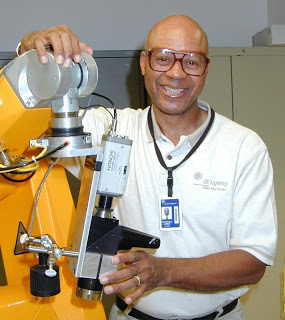By James Van Howe
 Dr. Marshall Jones from GE Global Research; Photo from GE
Dr. Marshall Jones from GE Global Research; Photo from GE
This post originally appeared on Jim’s Cleo Blog and is reproduced with permission from its author.
The head of the student machine shop at Cornell, Bob Snedeker ( Sned), liked to remind us in a sarcastic fashion that its easier to take material away from a workpiece than to put it back on- warning: be careful about how much you take off as you cut. Or as the old saying goes in carpentry, “measure twice, cut once.” This is not necessarily true for laser machining of metals. Laser cladding, which was one of the topics discussed in the tutorial, AMB1 “Industrial Applications of Laser Materials Processing,” by Dr. Marshall Jones from GE Global Research, is a technique in which material can be added to a workpiece where too much was accidentally cut off. Like Play-doh, you can just put back on what you need. Wow, if only I could have laser-cladded my tool bits, and special nut and bolt we were required to make in order to graduate from machine-shop training! Sned had high standards and we spent many hours to make a piece to find out we needed to start over with fresh stock. It was back to the grindstone (literally!) until those bits had a perfect angle and facet.
GE uses laser cladding to clean up mistakes that may have been made for particularly expensive pieces such as airfoils for aviation. You don’t want to throw these out and start over. Laser cladding is also used for coat metals with another protective metal surface- hardfacing.
Another laser processing technique explained by Marshall was laser-shock peening. Peening (as in a ball peen hammer-a remnant tool from days of blacksmithing) is a technique that reduces the fatigue of a metal (like preventing cracks from spreading) by applying a compression force to the surface. In the old days, this was done with a hammer, Marshall uses a “laser hammer.” To create a shock wave powerful enough to peen, you need a laser beam with an a power density of 1010 W/cm2 and an interaction time with the surface of no more than 10 ns. Using an interface like water, through which the compression force propagates to reach the metal surface, can make peening more effective. GE also uses shock peening for aviation pieces in order to extend the life of a particular part.
Besides other applications, Marshall briefly discussed the laser systems themselves. The conventional lasers used for processing are CO2 lasers and Nd:YAG systems. Unfortunately they have 10% and 3% wall-power efficiency respectively, and CO2 lasers require expensive specialty fiber for coupling due to the long emission wavelength. Ytterbium-doped fiber lasers and ampliers are beginning to replace these current workhorses due to high wall-power efficiency, 30%, and all-fiber configurations (zero optical alignment and high flexibility in footprint and beam delivery). The main disadvantage to high-power fiber lasers is expense. However, as fiber-systems continue to be developed, they may very well replace their bulk system competitors in the near-future…For the full original post, click here.
Posted: 3 May 2011 by
James Van Howe
| with 0 comments